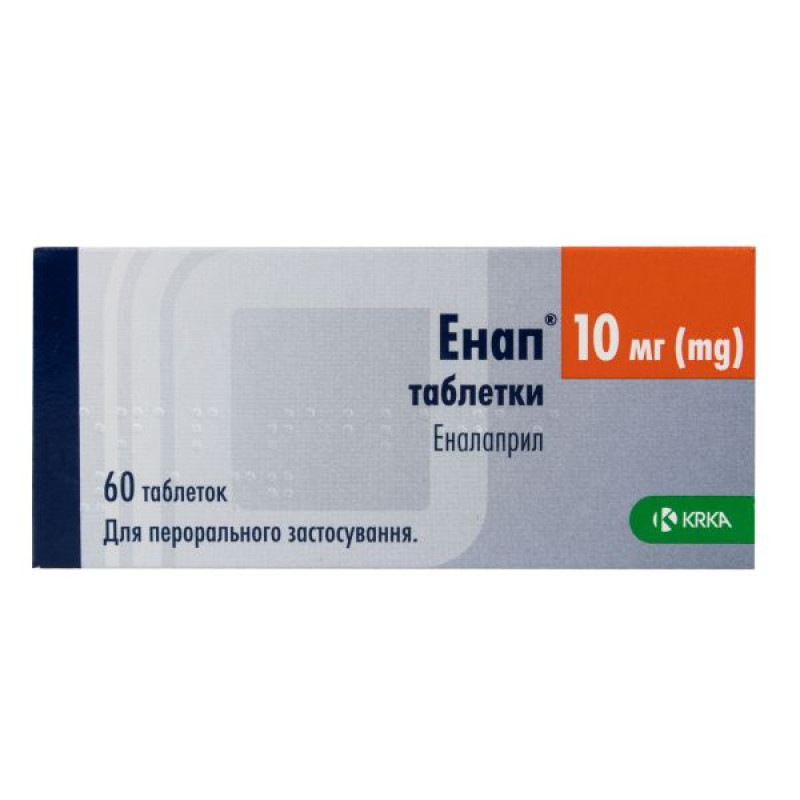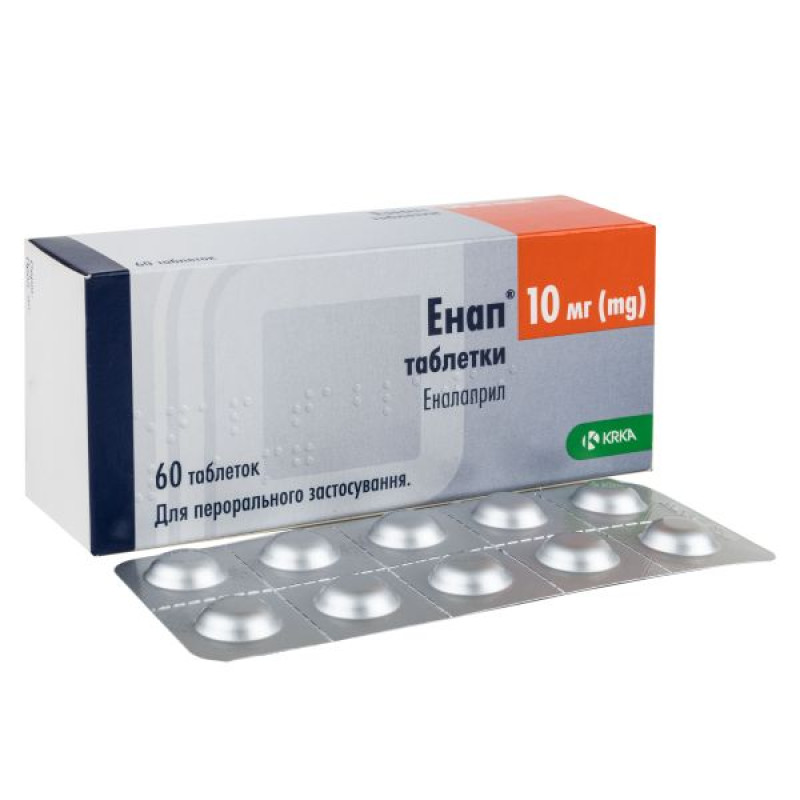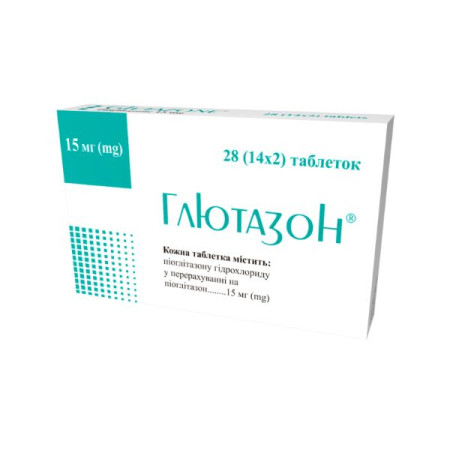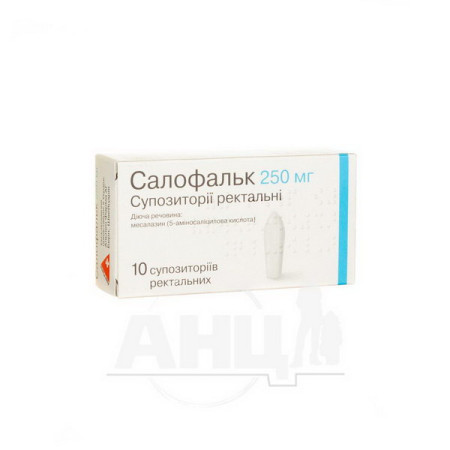Enap tablets 10 mg blister No. 60
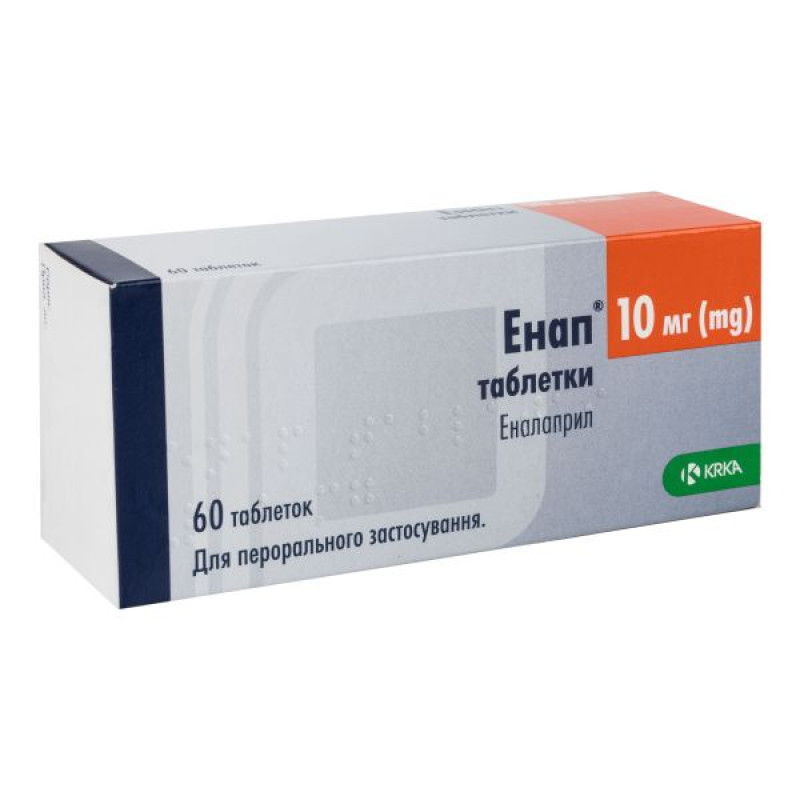
Instructions Enap tablets 10 mg blister No. 60
Composition
active substance: enalapril maleate;
1 tablet contains 2.5 mg or 5 mg or 10 mg or 20 mg of enalapril maleate;
auxiliary substances: tablets of 2.5 mg and 5 mg: sodium bicarbonate, lactose monohydrate, corn starch, hydroxypropyl cellulose, talc, magnesium stearate;
tablets of 10 mg and 20 mg: sodium bicarbonate, lactose, corn starch, talc, magnesium stearate, iron oxide red (E 172), iron oxide yellow (E 172) - only for tablets of 20 mg.
Medicinal form
Pills.
The main physical and chemical properties:
tablets 2.5 mg: round, biconvex tablets of white color with a beveled edge;
tablets 5 mg: round, flat tablets of white color with a beveled edge and a notch on one side;
tablets 10 mg: round, flat tablets of reddish-brown color with a beveled edge and a notch on one side, with splashes of white color on the surface and in the mass of the tablet;
tablets 20 mg: round, flat tablets of light orange color with a beveled edge and a notch on one side, with splashes of white color on the surface and in the mass of the tablet.
Pharmacotherapeutic group
Means acting on the renin-angiotensin system. Angiotensin-converting enzyme inhibitors. ATX code C09A A02.
Pharmacological properties
Pharmacodynamics
Enalapril maleate is a salt of maleic acid and enalapril, a derivative of two amino acids - L-alanine and L-proline.
Mechanism of action
Angiotensin-converting enzyme (ACE) is a peptidyl dipeptidase that catalyzes the conversion of angiotensin I into the pressor substance angiotensin II. After absorption, enalapril is hydrolyzed to enalaprilat, which suppresses ACE. Inhibition of ACE causes a decrease in the level of angiotensin II in the blood plasma, which leads to an increase in the activity of plasma renin (due to the inhibition of the negative feedback between the activity of angiotensin II and the release of renin) and a decrease in the secretion of aldosterone.
ACE is identical to kininase II. Thus, enalapril can also block the cleavage of bradykinin, a strong vasodepressor peptide. However, the significance of this phenomenon for the therapeutic effect of the drug remains unclear.
The mechanism by which enalapril lowers blood pressure is primarily associated with inhibition of the activity of the renin-angiotensin-aldosterone system (RAAS). Enalapril can show an antihypertensive effect even in patients with low-radical hypertension.
The use of the drug Enap® in the case of arterial hypertension causes a decrease in blood pressure in patients in horizontal and vertical positions without a significant increase in heart rate.
Symptomatic postural hypotension occurs infrequently. In some patients, it may take several weeks of therapy to achieve optimal blood pressure reduction. Abrupt withdrawal of the drug Enap® was not associated with a rapid increase in blood pressure.
Effective inhibition of ACE activity is usually achieved 2-4 hours after oral administration of a single dose of enalapril. The onset of antihypertensive activity is usually observed after 1 hour, and the peak decrease in blood pressure is reached after 4-6 hours after taking the drug. The duration of the effect depends on the dose. But in the case of use in the recommended doses, the antihypertensive and hemodynamic effects persisted for at least 24 hours.
In the course of hemodynamic studies in patients with essential hypertension, a decrease in blood pressure is usually accompanied by a decrease in the peripheral resistance of the arteries with an increase in cardiac output and a slight acceleration of the heart rate or without it. Renal blood flow increases after the use of enalapril, the rate of glomerular filtration does not change. There were no signs of sodium or water retention. However, in patients with low initial levels of glomerular filtration, these levels usually increased.
During short-term clinical studies in patients with impaired renal function, with or without diabetes mellitus, a decrease in albuminuria, urinary IgG excretion, and total urinary protein was observed after the use of enalapril.
When taken together with thiazide diuretics, the hypotensive effects of Enap® are at least additive. Enalapril can reduce or prevent the development of thiazide-induced hypokalemia.
In patients with mild and moderate heart failure, enalapril slowed the progression of myocardial dilatation/increase in myocardial mass and heart failure, as evidenced by reduced left ventricular end-diastolic and systolic volumes and improved ejection fraction.
Antihypertensive therapy with the drug Enap® leads to significant regression of left ventricular hypertrophy with preservation of left ventricular systolic function.
There is limited experience of the effective and safe use of the drug in children with arterial hypertension aged 6 years and older. 110 children with arterial hypertension aged 6 to 16 years with a body weight ≥ 20 kg, whose glomerular filtration rate was > 0.5 ml/sec/1.73 m2 were included in the clinical study. Children with body weight < 50 kg received 0.625 mg or 2.5 mg or 20 mg of enalapril 1 time per day, and children with body weight ≥ 50 kg received 1.25 mg or 5 mg or 40 mg of enalapril 1 time per day. The decrease in blood pressure depended on the dose; the effect was the same in all dosage subgroups (by age, Tanner stage, gender, race). Research results indicate that the lowest doses of 0.625 mg and 1.25 mg, that is, on average 0.02 mg/kg per day, do not provide therapeutic efficacy. The maximum dose was 0.58 mg/kg (40 mg) once a day. The profile of side effects in children did not differ from that in adult patients.
Pharmacokinetics
Absorption
Enalapril is quickly absorbed from the gastrointestinal tract, reaching a peak concentration in blood serum within 1 hour. The amount of absorption is approximately 60%, absorption is not affected by food consumption. After absorption, enalapril is quickly and extensively hydrolyzed to enalaprilat, a strong ACE inhibitor. The peak concentration of enalaprilat in blood serum is reached 4 hours after oral administration of a dose of enalapril. The effective half-life for the accumulation of enalaprilat after repeated use of enalapril is 11 hours. In patients with normal kidney function, the equilibrium concentration level of enalaprilat in blood serum is reached after four days of treatment.
Distribution
Within the entire range of therapeutic concentrations, 60% of enalaprilat binds to serum proteins.
Metabolism
With the exception of conversion to enalaprilat, there are no data on significant metabolism of enalapril.
Excretion
Enalaprilat is excreted mainly by the kidneys. The main components in the urine are enalaprilat, which makes up approximately 40% of the dose, and unchanged enalapril (approximately 20%).
Violation of kidney function
Enalapril and enalaprilat exposure increases in patients with renal failure. After administration of 5 mg once a day in patients with mild and moderate renal insufficiency (creatinine clearance 0.6-1 ml/sec), the AUC of enalaprilat in a stable state was approximately 2 times higher than in patients with normal renal function. With a severe form of renal failure (creatinine clearance 0.5 ml/sec), the AUC increased approximately 8 times. At this level of renal insufficiency, the effective half-life of enalaprilat is prolonged, and the time to reach a stable state increases.
Enalaprilat can be removed from the general circulation with the help of hemodialysis. The clearance of enalaprilat during dialysis is 1.03 ml/s.
Indications
Treatment of arterial hypertension.
Treatment of clinically pronounced heart failure.
Prevention of clinically pronounced heart failure in patients with asymptomatic left ventricular dysfunction (ejection fraction ≤ 35%).
Contraindications
Hypersensitivity to enalapril or to any other ingredients of the drug, or to other ACE inhibitors.
History of angioneurotic edema associated with previous treatment with ACE inhibitors.
Hereditary or idiopathic angioedema.
Pregnancy or pregnancy planning (see section "Use during pregnancy or breastfeeding").
Enap® should not be used with drugs containing aliskiren, in patients with diabetes mellitus or with impaired renal function (GFR < 60 ml/min/1.73 m2).
Simultaneous use in combination with neprilysin inhibitors (for example, sacubitril) - due to the increased risk of angioedema. The drug should not be used within 36 hours after the last dose of sacubitril/valsartan - a drug containing a neprilysin inhibitor, or after switching from it to another drug (see the sections "Particulars of use" and "Interaction with other medicinal products and other types of interactions").
Interaction with other medicinal products and other types of interaction
Although the level of potassium in the blood serum usually remains within the normal range, hyperkalemia may occur in some patients receiving enalapril. The use of potassium-sparing diuretics (for example, spironolactone, eplerenone, triamterene or amiloride), as well as the use of food additives or salt substitutes containing potassium, can lead to a significant increase in the level of potassium in the blood serum. Caution should also be exercised when enalapril is used together with other drugs that increase the level of potassium in the blood serum, such as trimethoprim and co-trimoxazole (trimethoprim/sulfamethoxazole), since trimethoprim is known to act as a potassium-sparing diuretic similar to amiloride. Therefore, the combination of enalapril with the above-mentioned drugs is not recommended. If the above means are indicated in connection with hypokalemia, they should be used with caution, regularly determining the level of potassium in the blood serum (see the section "Peculiarities of application").
Diuretics (thiazide or loop diuretics)
Preliminary treatment with diuretics in large doses can lead to a decrease in the volume of circulating blood and an increase in the risk of arterial hypotension at the beginning of enalapril therapy (see the section "Peculiarities of use"). Hypotensive effects can be reduced by stopping the diuretic, increasing salt intake, or starting therapy with a low dose of enalapril.
Other antihypertensive drugs
The combination of enalapril with other antihypertensive agents may increase the hypotensive effect of enalapril. Concomitant use with nitroglycerin, other nitrates, or other vasodilators can further reduce blood pressure.
Antidiabetic drugs
Epidemiological studies have shown that the combined use of ACE inhibitors and antidiabetic drugs (for example, insulin, oral hypoglycemic agents) can cause a decrease in blood glucose with a risk of hypoglycemia. This phenomenon is most likely during the first weeks of joint administration and if the patient has kidney failure (see the sections "Particulars of use", "Side effects").
Cast
With the simultaneous use of ACE inhibitors and lithium, a reversible increase in the level of lithium in the blood serum and toxicity was reported. Concomitant use of ACE inhibitors and thiazide diuretics can additionally increase the level of lithium in blood serum and increase the risk of lithium intoxication. It is not recommended to take enalapril with lithium, but if such a combination is necessary for the patient, careful monitoring of the level of lithium in the blood serum should be carried out (see the section "Peculiarities of use").
Tricyclic antidepressants/neuroleptics/anesthetics/hypnotics
Concomitant use of certain anesthetics, tricyclic antidepressants and neuroleptics with ACE inhibitors can lead to an additional decrease in blood pressure (see the section "Peculiarities of use").
Nonsteroidal anti-inflammatory drugs, including selective cyclooxygenase-2 inhibitors
Nonsteroidal anti-inflammatory drugs (NSAIDs), including selective cyclooxygenase-2 inhibitors (COX-2 inhibitors), can reduce the effect of diuretics and other antihypertensive drugs. Therefore, the hypotensive effect of antagonists of angiotensin II receptors (ARA) or ACE inhibitors can be weakened by NSAIDs, including selective COX-2 inhibitors.
Simultaneous use of NSAIDs, including COX-2 inhibitors, and ARA II or ACE inhibitors causes an additive effect on increasing potassium in blood serum and can lead to impaired kidney function. Usually these phenomena are reversible.
Rarely, acute renal failure is possible, especially in some patients with impaired renal function (for example, in elderly patients or in patients with reduced circulating blood volume, including those taking diuretics). Therefore, such a combination should be used with caution in patients with impaired kidney function. Patients should consume a sufficient amount of liquid; kidney function should be carefully monitored at the beginning of concomitant therapy and periodically during treatment.
Double blockade of the renin-angiotensin-aldosterone system.
Double blockade (for example, when adding an ACE inhibitor to ARA II) should be limited to isolated cases with careful monitoring of blood pressure, kidney function, and electrolyte levels. During several studies, it was reported that in patients with established atherosclerotic vascular disease, heart failure, or diabetes with end-organ damage, double blockade of the RAAS is associated with a higher frequency of arterial hypotension, syncope, hyperkalemia, and deterioration of kidney function (including acute renal failure) compared to the use of a single drug affecting the RAAS. ACE inhibitors and ARA II should not be used simultaneously in patients with diabetic nephropathy.
Enap® with aliskiren should not be used in patients with diabetes mellitus or with impaired renal function (GFR < 60 ml/min/1.73 m2) (see sections "Contraindications" or "Peculiarities of use").
Nitritoid reactions (symptoms including facial swelling, nausea, vomiting, and hypotension) have been reported occasionally in patients treated with injectable gold (sodium aurothiomalate) and a concomitant ACE inhibitor, including enalapril.
Drugs that increase the risk of angioedema
Simultaneous use with neprilysin inhibitors (for example, with sacubitril) is contraindicated due to the increased risk of angioedema (see the sections "contraindications" and "special features of use").
mTOR inhibitors
Concomitant use with racecadotril, mTOR inhibitors (such as temsirolimus, sirolimus, everolimus) and vildagliptin may lead to an increased risk of angioedema (see the section "Particulars of use").
Sympathomimetics
Sympathomimetics can reduce the antihypertensive effects of ACE inhibitors.
Alcohol
Alcohol enhances the hypotensive effect of ACE inhibitors.
Acetylsalicylic acid, thrombolytics and β-blockers
Enalapril can be safely used simultaneously with acetylsalicylic acid (in cardiac doses), thrombolytics and β-blockers.
Co-trimoxazole (trimethoprim/sulfamethoxazole)
In patients who simultaneously use co-trimoxazole (trimethoprim/sulfamethoxazole), the risk of hyperkalemia increases (see the section "Peculiarities of use").
Cyclosporine
Hyperkalemia may occur with simultaneous use of ACE inhibitors with cyclosporine. It is recommended to control the level of potassium in the blood serum.
Heparin
During the simultaneous use of ACE inhibitors with heparin, hyperkalemia may occur. It is recommended to control the level of potassium in the blood serum.
Features of application
Symptomatic hypotension
Symptomatic hypotension is rarely observed in patients with uncomplicated arterial hypertension. In patients with arterial hypertension receiving enalapril, symptomatic hypotension develops more often with hypovolemia, which occurs, for example, as a result of diuretic therapy, salt restriction, in patients on hemodialysis, as well as in patients with diarrhea or vomiting (see the sections "Interaction with other medicinal products and other types of interactions" and "Side effects"). Symptomatic hypotension was also observed in patients with heart failure, which was accompanied or not accompanied by renal failure. Symptomatic hypotension developed more often in patients with more severe forms of heart failure who were treated with high doses of loop diuretics, with hyponatremia or impaired kidney function. Such patients should start therapy with the drug Enap® under the supervision of a doctor. When changing the dose of the drug and/or diuretic, monitoring should be especially careful. Patients with ischemic heart disease, as well as cerebrovascular diseases, in which an excessive decrease in blood pressure can lead to myocardial infarction or stroke, should be similarly monitored.
With the development of arterial hypotension, the patient should be placed in a horizontal position and, if necessary, enter intravenous physiological solution. Transient arterial hypotension when taking enalapril is not a contraindication for further use, which can be continued usually without complications after normalization of blood pressure by restoring fluid volume.
In some patients with heart failure with normal or low blood pressure, enalapril may further reduce blood pressure. Such a reaction to taking the drug is expected and is usually not a reason to stop treatment. In the event that arterial hypotension becomes resistant to treatment, the dose should be reduced and/or treatment with diuretic and/or enalapril should be stopped.
Aortic or mitral stenosis/hypertrophic cardiomyopathy
Like all vasodilators, ACE inhibitors should be used with caution in patients with left ventricular outflow tract obstruction and outflow tract obstruction and should be avoided in case of cardiogenic shock and hemodynamically significant obstruction.
Violation of kidney function
In patients with impaired renal function (creatinine clearance < 1.33 ml/c), the initial dose of enalapril should be selected in accordance with creatinine clearance (see the section "Method of administration and dosage") and further - taking into account the response to treatment. Regular monitoring of potassium and creatinine levels is standard medical practice for such patients.
In some patients with arterial hypertension, in whom kidney disease was not detected before the start of treatment, enalapril together with diuretics caused a usually insignificant and transient increase in the content of urea in the blood and creatinine in the blood serum. In such cases, it may be necessary to reduce the dose and/or cancel the diuretic. This situation increases the probability of existing stenosis of the renal artery (see the section "Peculiarities of use": Renovascular hypertension).
Renovascular hypertension
There is an increased risk of arterial hypotension and renal failure when patients with bilateral renal artery stenosis or stenosis of the artery to the only functioning kidney are treated with ACE inhibitors. Loss of kidney function is possible even with minimal changes in the level of creatinine in blood serum. Such patients should be treated with small doses under close medical supervision with careful titration and monitoring of kidney function.
Kidney transplantation
There is no experience of using Enap® in patients who have recently undergone kidney transplantation. Therefore, treatment with Enap® is not recommended for these patients.
Liver failure
Rarely, ACE inhibitors have been associated with a syndrome that begins with cholestatic jaundice or hepatitis and progresses to instantaneous liver necrosis and (sometimes) death. The mechanism of this syndrome remains unclear. Patients taking ACE inhibitors who develop jaundice or a marked increase in liver enzymes should stop taking the ACE inhibitor and be under appropriate medical supervision.
Neutropenia / agranulocytosis
Neutropenia/agranulocytosis, thrombocytopenia, and anemia have been reported in patients taking ACE inhibitors. In patients with normal kidney function and in the absence of other complicating factors, neutropenia rarely occurred. Enalapril should be prescribed very carefully to patients with vascular collagenosis who are undergoing immunosuppressive therapy, treatment with allopurinol or procainamide, or with a combination of these complicating factors, especially if there is already impaired kidney function. Some of these patients developed serious infections that sometimes did not respond to intensive antibiotic therapy. When enalapril is prescribed to such patients, periodic monitoring of the number of leukocytes is recommended. Patients must report any signs of infection.
Hypersensitivity/angioedema
When using ACE inhibitors, including enalapril, isolated cases of angioedema of the face, limbs, lips, tongue, glottis and/or larynx, which occurred in different periods of treatment, were described. In these cases, treatment with enalapril should be stopped immediately and constant monitoring of the patient's condition should be established to ensure complete disappearance of symptoms. Only after this observation can you stop. Even in the case of swelling of only the tongue without breathing disorders, patients may need long-term observation, since treatment with antihistamines and corticosteroids may not be enough.
Angioneurotic edema of the larynx or edema of the tongue has been reported very rarely. If the edema is localized in the area of the tongue, glottis or larynx, especially in patients with a history of surgical interventions on the respiratory tract, airway obstruction may develop. When the tongue, pharynx or larynx is involved in the process and this can cause airway obstruction, appropriate therapy should be started immediately, which may include subcutaneous administration of a 1:1000 solution of adrenaline (0.3-0.5 ml) and/or measures to ensure airway patency.
Angioneurotic edema occurred more often in black patients who used ACE inhibitors compared to patients of other races.
Patients with a history of angioneurotic edema, which is not associated with the use of ACE inhibitors, may have an increased risk of its occurrence even during treatment with an ACE inhibitor (see the section "Contraindications").
The simultaneous use of ACE inhibitors with sacubitril/valsartan is contraindicated due to the increased risk of angioedema. Sacubitril/valsartan should not be started within 36 hours after the last dose of enalapril. Therapy with enalapril should not be started within 36 hours after the last dose of sacubitril/valsartan (see sections "contraindications" and "special features of use").
Concomitant use of ACE inhibitors with racecadotril, mTOR inhibitors (for example, sirolimus, everolimus, temsirolimus) and vildagliptin may lead to an increased risk of angioedema, for example, swelling of the airways or tongue, with or without respiratory failure (see section "Interaction with other medicinal products and other types of interactions").
Caution should be exercised when starting racecadotril, mTOR inhibitors (eg, sirolimus, everolimus, temsirolimus) and vildagliptin in patients who are already taking an ACE inhibitor.
Occasionally, anaphylactoid reactions, which could be life-threatening to patients, have developed in patients receiving ACE inhibitors during hyposensitization to the hymenoptera venom allergen. Similar reactions can be avoided if you temporarily stop taking an ACE inhibitor before the onset of hyposensitization.
Anaphylactoid reactions during apheresis of low-density lipoproteins
Rarely, life-threatening anaphylactoid reactions have occurred in patients taking ACE inhibitors during low-density lipoprotein apheresis with dextran sulfate. Such reactions can be avoided by temporarily stopping the intake of ACE inhibitors before each apheresis.
Patients on hemodialysis
Anaphylactoid reactions have sometimes developed in patients undergoing dialysis using high-permeability membranes (for example, AN 69®) and using an ACE inhibitor at the same time. Therefore, for such patients, it is recommended to consider the use of dialysis membranes of the second type or hypotensive agents of the second group.
Hypoglycemia
Patients with diabetes who take oral antidiabetic drugs or insulin and start therapy with an ACE inhibitor should be recommended to carefully check their blood sugar, especially during the first few months of concomitant use (see the section "Interaction with other medicinal products and other types of interactions").
Cough
Cough has been reported during treatment with ACE inhibitors. Usually, the cough has an unproductive persistent character and stops after the withdrawal of the drug. Cough due to treatment with an ACE inhibitor should be taken into account in the differential diagnosis of cough.
Conducting surgical operations/anesthesia
During major surgical operations or under anesthesia with the use of drugs that cause arterial hypotension, enalapril blocks the formation of angiotensin II secondary to the compensatory release of renin. If at the same time arterial hypotension develops, which can be explained by these mechanisms of interaction, it is corrected by increasing the volume of fluid.
Hyperkalemia
In some patients who received ACE inhibitors, including enalapril, an increase in the level of potassium in the blood serum was observed. The risk of hyperkalemia is increased in patients with renal failure, hypoaldosteronism, impaired renal function, in patients aged > 70 years, patients with diabetes mellitus, transient conditions, in particular dehydration, acute cardiac decompensation, metabolic acidosis, and in patients who concomitantly take potassium-sparing diuretics (for example, spironolactone, eplerenone, triamterene, or amiloride); when using food additives or salt substitutes containing potassium; as well as in the case of taking other drugs that can cause an increase in potassium in the blood (for example, heparin, trimethoprim or co-trimoxazole, also known as trimethoprim/sulfamethoxazole, and especially aldosterone antagonists or angiotensin receptor blockers). In particular, taking potassium-sparing diuretics, dietary supplements or salt substitutes containing potassium in patients with impaired kidney function can lead to a significant increase in the level of potassium in the blood. Hyperkalemia can cause serious, sometimes fatal arrhythmias. Potassium-sparing diuretics and adrenoblockers of angiotensin receptors should be used with caution in patients receiving ACE inhibitors, and the potassium content in the blood serum should be regularly monitored (see the section "Interaction with other medicinal products and other types of interactions").
Cast
Usually, the combination of lithium and enalapril is not recommended (see the section "Interaction with other medicinal products and other types of interactions").
Concomitant therapy with an ACE inhibitor and an angiotensin receptor antagonist
Combining an ACE inhibitor with ARA II should be limited to individually determined cases, which are accompanied by careful monitoring of kidney function, potassium level, and blood pressure (see the section "Interaction with other medicinal products and other types of interactions").
Application to children
The experience of its effectiveness and safety in children with hypertension older than 6 years is limited, but according to other indications, there is no experience. Limited pharmacokinetic data for use in children older than 2 months are available (see sections "Method of administration and dosage", "Pharmacodynamics" and "Pharmacokinetics").
Enalapril is not recommended for children for other indications than arterial hypertension.
Due to the lack of safety data, enalapril is not recommended for newborns and pediatric patients with a glomerular filtration rate < 30 ml/min/1.73 m2.
Pregnancy/breastfeeding period
Racial affiliation
Enalapril, like other ACE inhibitors, lowers blood pressure less effectively in patients with arterial hypertension of the Negroid race than in people of other races, which may be explained by the low level of renin in the blood plasma of such patients.
Special warnings regarding inactive ingredients
Enap® contains lactose. Patients with rare hereditary disorders of galactose deficiency, lactose deficiency or glucose-galactose malabsorption syndrome should not use this drug.
Use during pregnancy or breastfeeding
Pregnancy
ACE inhibitors are contraindicated for use by pregnant women and women planning pregnancy (see section "Contraindications").
Patients planning pregnancy should be transferred to an alternative antihypertensive treatment that has an approved safety profile for use during pregnancy. If pregnancy is established, treatment with ACE inhibitors should be stopped immediately and, if possible, alternative therapy should be started.
Epidemiological conclusions regarding the risk of teratogenicity after exposure to ACE inhibitors during the first trimester of pregnancy are not unambiguous, however, a small increase in risk cannot be excluded. It is known that the use of ACE inhibitors during the II and III trimesters of pregnancy can lead to the development of fetotoxicity (reduced kidney function, oligohydramnios, retardation of ossification of the skull) and neonatal toxicity (renal failure, arterial hypotension, hyperkalemia).
If ACE inhibitors were used in the II trimester of pregnancy, it is recommended to conduct an ultrasound examination of kidney and skull function.
Infants, whose mothers took ACE inhibitors, should be carefully checked for arterial hypotension, oliguria, and hyperkalemia (see sections "Contraindications" and "Peculiarities of use").
Breastfeeding period
Limited pharmacokinetic data indicate a very low concentration in breast milk. Although such concentrations are considered clinically insignificant, the use of Enap® is not recommended during breastfeeding of premature infants and infants in the first few weeks after birth, as there is a hypothetical risk of effects from the cardiovascular system and kidneys, as well as due to insufficient experience with such use. In relation to older babies, the use of the drug Enap® during breastfeeding can be considered if the treatment is necessary for the mother, and the child will be monitored for the appearance of any side effects.
The ability to influence the speed of reaction when driving a motor vehicle or other mechanisms
When driving a motor vehicle or working with other mechanisms, the possible development of dizziness or increased fatigue should be taken into account.
Method of application and dosage
Tablets should be taken whole with a small amount of water regardless of food intake. The drug should be taken at the same time every day. Do not take two doses at the same time.
The dosage must be selected individually, in accordance with the condition of each patient (see the section "Peculiarities of use") and blood pressure reactions in response.
Arterial hypertension
The dose of the drug ranges from an initial 2.5 mg to a maximum of 20 mg once a day, depending on the degree of arterial hypertension and the patient's condition. With mild arterial hypertension, the recommended starting dose is 5-10 mg.
In patients with highly activated RAAS (for example, with renovascular hypertension, salt and/or fluid imbalance, decompensation of cardiac function, or severe arterial hypertension), an excessive decrease in blood pressure after taking the initial dose is possible. For such patients, an initial dose of 5 mg or lower is recommended, and at the beginning of treatment, the patient must be under the supervision of a doctor.
Preliminary therapy with high doses of diuretics can lead to fluid deficit and the risk of arterial hypotension at the beginning of enalapril therapy. For such patients, an initial dose of 5 mg or lower is recommended. If possible, diuretic therapy should be stopped 2-3 days before starting treatment with Enap®. For patients who cannot stop taking diuretics p
There are no reviews for this product.
There are no reviews for this product, be the first to leave your review.
No questions about this product, be the first and ask your question.







